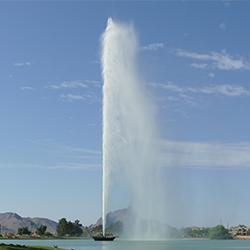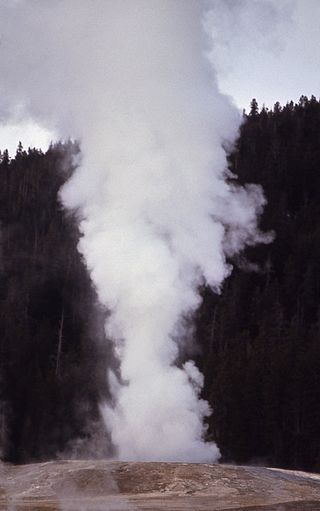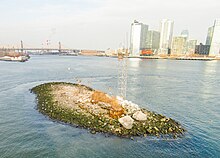
The East River is a saltwater tidal estuary or strait in New York City. The waterway, which is not a river despite its name, connects Upper New York Bay on its south end to Long Island Sound on its north end. It separates Long Island, with the boroughs of Brooklyn and Queens, from Manhattan Island, and from the Bronx on the North American mainland.

Roosevelt Island is an island in New York City's East River, within the borough of Manhattan. It lies between Manhattan Island to the west, and the borough of Queens, on Long Island, to the east. It is about 2 miles (3.2 km) long, with an area of 147 acres (0.59 km2), and had a population of 11,722 as of the 2020 United States census. It consists of two largely residential communities: Northtown and Southtown. Roosevelt Island is owned by the city but was leased to the New York State Urban Development Corporation (UDC) for 99 years in 1969.

Fountain Hills is a town in Maricopa County, Arizona, United States. Known for its impressive fountain, once the tallest in the world, it borders the Fort McDowell Yavapai Nation, Salt River Pima-Maricopa Indian Community, and Scottsdale. The population was 23,820 as of the 2020 census. Between the 1990 and 2000 censuses it was the eighth-fastest-growing place among cities and towns in Arizona. The median value of an owner-occupied housing during the period 2016–2020 was estimated at $402,100.

A fountain, from the Latin "fons", meaning source or spring, is a decorative reservoir used for discharging water. It is also a structure that jets water into the air for a decorative or dramatic effect.

The Roosevelt Island Tramway is an aerial tramway that crosses the East River in New York City, connecting Roosevelt Island to the Upper East Side of Manhattan. The tramway is the first commuter aerial tramway in the U.S., having opened on May 17, 1976, to serve residential developments on Roosevelt Island. The tram is operated by Leitner-Poma on behalf of the Roosevelt Island Operating Corporation of the State of New York.

U Thant Island is a small artificial island or islet in the borough of Manhattan in New York City. The 100-by-200-foot island, created during the construction of the Steinway Tunnel directly underneath, is the smallest island in Manhattan.

A musical fountain, also known as a fairy fountain, prismatic fountain or dancing fountain, is a type of choreographed fountain that creates aesthetic designs as a form of entertainment. The displays are commonly synchronised to music and also feature lighting effects that are refracted and reflected by the moving water. Contemporary multimedia fountains can include lasers, video projection and three-dimensional imagery.

Malcolm W. Martin Memorial Park is a park on the east side of the Mississippi River in East St. Louis, Illinois, directly across from the Gateway Arch and the city of St. Louis, Missouri. For 29 years, its major feature was the Gateway Geyser, a fountain that lifted water up to 630 feet (192 m), the same height as the Arch. Four smaller fountains around the Geyser represent the four rivers which converge near the two cities: The Mississippi, Missouri, Illinois, and Meramec. It was closed in 2023 due to costs of refurbishment and to prepare the park for being handed over to the National Park Service as an extension of the Gateway memorial. The park also includes an elevated viewing point overlooking the river.

George T. Delacorte Jr. was an American magazine publisher, born in New York City.

Saratoga Spa State Park is a 2,379-acre (9.63 km2) state park located in Saratoga County, New York in the United States. The park is in the City of Saratoga Springs, near US 9 and NY 50.

The Roosevelt Island Bridge is a tower drive vertical lift bridge that connects Roosevelt Island in Manhattan to Astoria in Queens, crossing the East Channel of the East River. It is the sole route to the island for vehicular and foot traffic.

A combination of aqueducts, reservoirs, and tunnels supplies fresh water to New York City. With three major water systems stretching up to 125 miles (201 km) away from the city, its water supply system is one of the most extensive municipal water systems in the world.
The Roosevelt Island Operating Corporation (RIOC) is a New York State public-benefit corporation responsible for developing Roosevelt Island, a small island in the East River that is part of the New York City borough of Manhattan.

Friendship Fountain is a large fountain in Jacksonville, Florida. It is in St. Johns River Park at the west end of Downtown Jacksonville's Southbank Riverwalk attraction. The world's largest and tallest fountain when it opened, it has been one of Jacksonville's most recognizable and popular attractions.

Blackwell Island Lighthouse, now known as Roosevelt Island Lighthouse, also was known as Welfare Island Lighthouse, is a stone lighthouse built by the government of New York City in 1872. It is within Lighthouse Park at the northern tip of Roosevelt Island in the East River. It was named to the National Register of Historic Places on March 16, 1972 and was designated a New York City Landmark on March 23, 1976.

Giantess Geyser is a fountain-type geyser in the Upper Geyser Basin of Yellowstone National Park. It is known for its violent and infrequent eruptions of multiple water bursts that reach from 100 to 200 feet. Eruptions generally occur 2 to 6 times a year. The surrounding area may shake from underground steam explosions just before the initial water and/or steam eruptions. Eruptions may occur twice hourly, experience a tremendous steam phase, and continue activity for 4 to 48 hours. The Geyser last erupted on August 26, 2020, after a six-year, 210 day hiatus. A follow-up eruption occurred 15 days later on 10 September 2020. Another eruption occurred on 11 August 2021

The Franklin D. Roosevelt Four Freedoms Park is a four-acre (1.6 ha) memorial to Franklin D. Roosevelt that celebrates the Four Freedoms he articulated in his 1941 State of the Union address. It is located in New York City at the southernmost point of Roosevelt Island, in the East River between Manhattan Island and Queens. It was originally designed by the architect Louis Kahn in 1974, but funds were only secured for groundbreaking in 2010 and completion in 2012.

Bailey Fountain is an outdoor sculpture in New York City at the site of three 19th century fountains in Grand Army Plaza, Brooklyn, New York, United States. Renovated in 1956 and 2005-06, the 1932 fountain was funded by philanthropist Frank Bailey as a memorial to his wife Marie Louise Bailey. After 1974 thefts, some sculpture elements were stored for safekeeping. The bronze Art Deco design of the Bailey Fountain consists of six monumental figures beginning with the top two, a man representing Wisdom with his left hand on the tiller steering the ship of Life and a woman representing Felicity with her right hand holding a cornucopia. Below them are two other statues, one a chubby standing child helping to shoulder that cornucopia while the second is a laughing Greek mythological figure called Nereus who is the eldest son of Pontus the Sea and Gaia the Earth. To the sides of the fountain are the two remaining aquatic Nereides / sea nymph figures with upper torsos emerging from the water their heads back trumpeting with conch shells as their fish tails twist in the background.

Vaillancourt Fountain, sometimes called Québec libre!, is a large fountain in Embarcadero Plaza in San Francisco, designed by the Québécois artist Armand Vaillancourt in collaboration with the plaza's landscape architect, Lawrence Halprin, and completed in 1971. It is about 40 feet (12 m) high and is constructed out of precast concrete square tubes. Long considered controversial because of its stark, modernist appearance, there have been several unsuccessful proposals to demolish the fountain over the years. It was the site of a free concert by U2 in 1987, when lead singer Bono spray painted graffiti on the fountain and was both praised and criticized for the action.

Revson Fountain is a fountain installed in the Lincoln Center for the Performing Arts, a complex of buildings in the Lincoln Square neighborhood of the borough of Manhattan in New York City. The fountain was dedicated in 1964 and a redesign was completed in 2009.






















